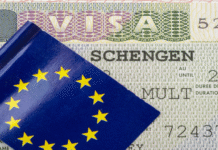India has reinstated tourist e-visas for Chinese citizens after a five-year suspension, a decision widely viewed as a strategic move to re-engage with one of Asia’s largest outbound tourism markets and revive its own struggling inbound travel sector. The announcement, made by the Indian Embassy in Beijing on July 24, 2025, marks a new chapter in post-pandemic regional travel and cultural diplomacy between two of the world’s most populous nations.
The e-visa reinstatement is expected to provide a strong tailwind for Indian tourism, which has faced years of suppressed growth due to COVID-19 disruptions, geopolitical tensions, and restricted air connectivity with China—previously one of the world’s top-spending tourist markets.
Tourism at a Crossroads: From Collapse to Recovery
The decision follows a dramatic collapse in Chinese tourist arrivals to India—from 340,000 visitors in 2019 (2.7% of total foreign arrivals) to just 30,000 in 2023, according to Ministry of Tourism data. The five-year freeze, which began in the wake of the pandemic and 2020 border clashes, decimated one of India’s most promising tourism segments.
With the visa portal now reactivated, officials estimate a rebound to 200,000+ Chinese arrivals in 2025–26, with the potential to generate over ₹3,000 crore in direct and ancillary tourism revenue, based on historical average spend per tourist of ₹1.5 lakh.
What the New E-Visa Regime Offers
Chinese nationals can now apply for tourist e-visas through the official Indian visa portal. Key enhancements to the process include:
- Online Application System: Eased access via the Indian Visa Application website.
- Biometric Verification: Submission required at designated visa centers in Beijing, Shanghai, and Guangzhou.
- Faster Turnaround: Reduced processing times for leisure travel, spiritual tourism, and group tours.
This comes as Indian tour operators, hospitality chains, and digital travel platforms mobilize to capture renewed interest from Chinese travellers. Brands like MakeMyTrip and Thomas Cook are reportedly developing Mandarin-language platforms, while state tourism boards are preparing targeted roadshows and digital campaigns for the Chinese market.
Cultural & Religious Tourism to Drive Demand
Pre-pandemic, Chinese tourists were drawn to India’s deeply spiritual and heritage-rich circuits. Their preferences included:
- The Golden Triangle: Delhi, Agra (Taj Mahal), and Jaipur for architecture and culture.
- Buddhist Pilgrimage Routes: Bodh Gaya, Sarnath, Nalanda, and Kushinagar.
- Wellness Destinations: Kerala, Rishikesh, and Goa for Ayurveda and yoga retreats.
- Shopping and Culinary Tourism: Across metro cities and heritage towns.
India’s robust Buddhist heritage offers a natural magnetism for the Chinese market. Sites such as Bodh Gaya (site of Buddha’s enlightenment), Sarnath (first sermon), and Nalanda (ancient monastic university) remain especially popular. The Ministry of Tourism’s Swadesh Darshan 2.0 and PRASHAD schemes are already enhancing infrastructure around these heritage zones, aiming to elevate tourist experience and accessibility.
Tourism Startups & Local Businesses Set to Gain
The impact of the visa reinstatement is likely to extend beyond traditional tourist circuits. Travel startups, especially those focused on experiential travel, wellness tourism, and slow travel, are expected to see renewed traction from the Chinese segment.
At the grassroots level, beneficiaries will include:
- Homestays and Boutique Hotels in heritage cities
- Local Handicraft Artisans and Culinary Tour Operators
- Guides and Translators, particularly those with Mandarin proficiency
- Regional Transport Services in Buddhist and wellness circuits
This could deliver a multiplier effect for local economies, particularly in destinations like Jaipur, Varanasi, Dharamshala, and Coimbatore—which combine spirituality, culture, and offbeat tourism appeal.
Strategic Implications for India-China Relations
Beyond economics, the move reflects a gradual normalization in bilateral ties. The Chinese Ministry of Foreign Affairs called India’s decision a “constructive step” that could help facilitate smoother people-to-people exchanges. Analysts also view it as part of a broader realignment, where tourism diplomacy may soften entrenched geopolitical tensions through cultural interdependence.
The resumption of the Kailash Mansarovar Yatra via the Lipulekh and Nathu La routes in June 2025—following a hiatus due to pandemic and border-related restrictions—further underscores the rekindling of spiritual and cultural travel corridors between the two countries.
Challenges: Language, Payments & Infrastructure
However, unlocking the full potential of Chinese outbound travel will require India to address several longstanding bottlenecks:
- Language Barriers: A limited supply of Mandarin-speaking staff in hotels, airports, and tourist sites hampers communication.
- Digital Payments: Chinese travellers are accustomed to QR-based payment systems (e.g., WeChat Pay, Alipay), which are not widely accepted in India.
- Cultural Readiness: Hospitality providers will need better training on Chinese travel preferences—ranging from food habits to tipping norms.
The development of multilingual city apps, QR-code menus, and Mandarin-enabled transport and museum services is underway in several tourism hubs, but a broader, coordinated effort will be needed to compete with destinations like Thailand, Vietnam, and Sri Lanka.
Conclusion: A Timely, Strategic Opening
India’s reinstatement of tourist e-visas for Chinese nationals is not just an administrative change—it’s a statement of intent. It reflects a strategic push to reclaim a key source market, reignite inbound travel, and reposition India as a premier cultural and spiritual destination in Asia.
With the right combination of policy support, digital innovation, and hospitality training, India has the potential to turn this decision into a tourism milestone—transforming what was once a lost market into a driving force for post-pandemic recovery.










